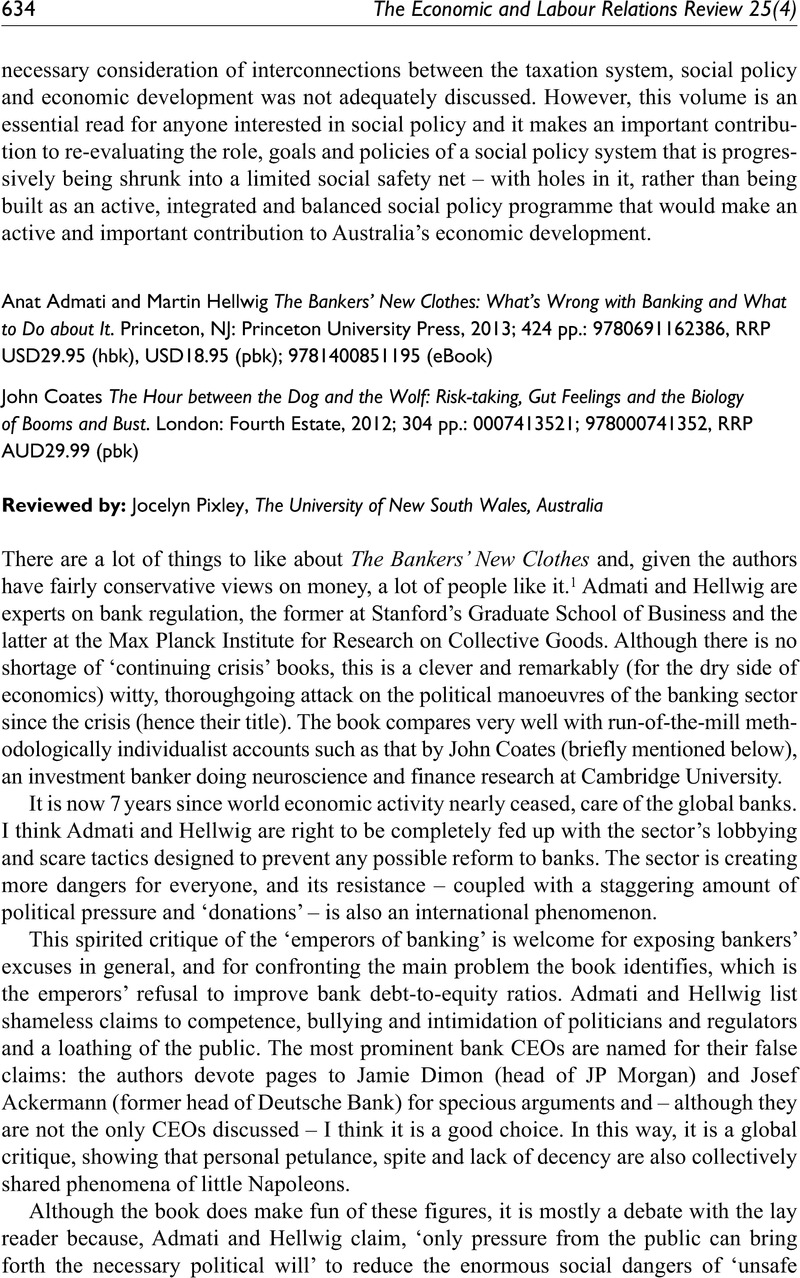No CrossRef data available.
Article contents
Anat Admati and Martin HellwigThe Bankers’ New Clothes: What’s Wrong with Banking and What to Do about It. Princeton, NJ: Princeton University Press, 2013; 424 pp.: 9780691162386, RRP USD29.95 (hbk), USD18.95 (pbk); 9781400851195 (eBook) - John CoatesThe Hour between the Dog and the Wolf: Risk-taking, Gut Feelings and the Biology of Booms and Bust. London: Fourth Estate, 2012; 304 pp.: 0007413521; 978000741352, RRP AUD29.99 (pbk)
Review products
Anat Admati and Martin Hellwig The Bankers’ New Clothes: What’s Wrong with Banking and What to Do about It. Princeton, NJ: Princeton University Press, 2013; 424 pp.: 9780691162386, RRP USD29.95 (hbk), USD18.95 (pbk); 9781400851195 (eBook)
John Coates The Hour between the Dog and the Wolf: Risk-taking, Gut Feelings and the Biology of Booms and Bust. London: Fourth Estate, 2012; 304 pp.: 0007413521; 978000741352, RRP AUD29.99 (pbk)
Published online by Cambridge University Press: 01 January 2023
Abstract
An abstract is not available for this content so a preview has been provided. Please use the Get access link above for information on how to access this content.

- Type
- Book reviews
- Information
- The Economic and Labour Relations Review , Volume 25 , Issue 4: Symposium: A new global economics? Environment, development, equity , December 2014 , pp. 634 - 641
- Copyright
- © The Author(s) 2014
References
Australian Prudential Regulation Authority (APRA) (2013) Prudential Standard APS 110: capital adequacy. Available at: http://www.apra.gov.au/adi/PrudentialFramework/Documents/Basel-III-Prudential-Standard-APS-110-%28January-2013%29.pdf (accessed 20 September 2014)Google Scholar
Australian Prudential Regulation Authority (APRA) (2014) APRA improves capital-raising options for mutual ADIs. Media Release, 15 April. Available at: http://www.apra.gov.au/MediaReleases/Pages/14_08.aspx (
accessed 20 September 2014)Google Scholar
Bernanke, B (2013) The Federal Reserve and the Financial Crisis. Princeton, NJ: Princeton University Press.CrossRefGoogle Scholar
Board of Governors of the Federal Reserve System (2014) Federal Open Market Committee (Transcript December 2007). Available at: http://www.federalreserve.gov/monetarypolicy/fomc.htm (
accessed 20 September 2014).Google Scholar
Freedman, C (2006) Not for love nor money: Milton Friedman’s counter-revolution. History of Economics Review 44: 87–119.Google Scholar
McLeay, M, Radia, A, Thomas, R (2014) Money creation in the modern economy. Bank of England Quarterly Bulletin Q1: 4–27.Google Scholar
Merton, RK (1957) Social Theory and Social Structure. Glencoe, IL: The Free Press of Glencoe.Google Scholar
Pixley, JF (2010) The use of risk in understanding financial decisions. The Journal of Socio-Economics 39(2): 209–222.CrossRefGoogle Scholar
Pixley, JF (2011) Sociology of uncertainty. In:
Mica, A, Peisert, A, Winczorek, J (eds) Sociology and the Unintended. Robert Merton Revisited. Frankfurt am Main: Peter Lang Publishers, pp. 89–111.Google Scholar
Pixley, JF (2012) Emotions in Finance: Booms, Busts and Uncertainty. 2nd ed. Cambridge: Cambridge University Press.Google Scholar
Potter, B (2014) Robb hits APRA over red tape ‘costs’. Australian Financial Review, 16 May, pp. 1, 18.Google Scholar
Schumpeter, JA (1954) History of Economic Analysis. New York: Oxford University Press.Google Scholar
Weber, M ([1909] 2012) ‘Energetical’ theories of culture. In:
Brunn, HH, Whimster, S (eds) Max Weber: Collected Methodological Writings. London: Routledge, pp. 252–268.Google Scholar


